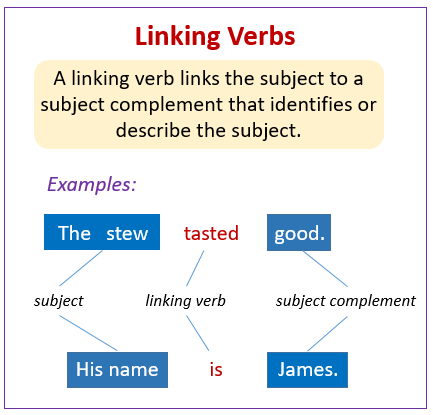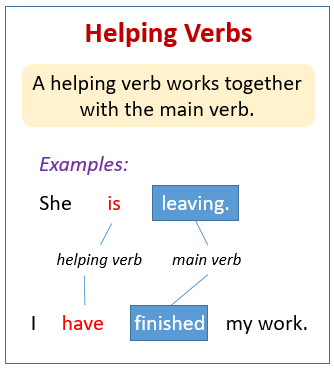Action Verbs, Linking Verbs
In these lessons, we will look at verbs are and the role of verbs in a sentence.
Related Pages
Verbs: Simple Present Tense
Simple Past Tense For Irregular Verbs
IELTS, TOEFL And English As A Second Language
More Lessons On English Grammar
A noun or a pronoun, no matter how many modifiers it may have, cannot make a sentence. The noun or pronoun must act in some way, or something must be said about it. The part of speech that performs this function is the verb.
What is a Verb?
A verb is a word that expresses action or otherwise helps to make a sentence.
There are three main types of verbs: Action Verbs, Linking Verbs and Helping Verbs.
The following diagrams show the 3 main types of verbs: action verbs, linking verbs, and helping verbs. Scroll down the page for more examples and explanations of verbs.



Action Verbs
Words such as do, come, go and write are action verbs. Sometimes action verbs express an action that cannot be seen: believe, remember, know, think and understand.
Transitive and Intransitive Verbs
There are two large classes of action verbs – transitive and intransitive.
A verb is transitive when the action it expresses is directed toward a person or thing named in the sentence. The action passes from the doer (the subject) to the receiver of the action (the object)
Examples:
Jane ate the apple. (The action of the verb ate is directed toward apple. The subject is Jane and the object is apple)
John threw the ball. (The action of the verb threw is directed toward ball. The subject is John and the object is the ball)
A verb is intransitive when it expresses action (or helps to make a statement) without reference to the object.
Examples:
The children behaved very well.
The bus arrived on time.
The same verb may be transitive in one sentence and intransitive in another.
Examples:
She speaks English. (Transitive – the object is English)
She speaks fluently. (Intransitive – there is no object)
Linking Verbs
Some verbs help to make a statement, not by expressing an action but by serving as a link between two words. These verbs are called linking verbs.
The most commonly used linking verbs are forms of the verb be.
Some forms of the verb be are:
| am | be | has been |
| is | shall be | have been |
| are | will be | had been |
| was | should be | shall have been |
| were | would be | will have been |
| being | could be | should have been |
| can be | would have been | |
| could have been |
Another two common linking verb are become and seem.
Examples:
His name is James. (is joins name with James)
Andy could have been a dentist. (could have been joins Andy with dentist)
The soup smells good. (smells joins soup with good).
The light remained green. (remained joins light with green)
Some linking verbs can be used as action verbs as well.
Examples:
| appear | look | sound | turn |
| feel | remain | stay | prove |
| grow | smell | taste |
Examples:
The stew tasted good. (linking verb)
Paul tasted the stew. (action verb)
How can we tell when a verb is an action verb or a linking verb?
If we can substitute the verb with is/are/am and the sentence still sounds logical then it is a linking verb.
Examples:
“The stew tasted good” can be changed to “The stew is good”. (Tasted is then a linking verb.)
“Paul tasted the stew” cannot be changed to “Paul is the stew” (Tasted is then an action verb.)
Helping Verbs or Auxiliary Verbs
Helping verbs (also called auxiliary verbs) work together with the main verb as a unit. There are two main groups of helping verbs: Primary Helping Verbs and Modal Helping Verbs.
Primary Helping Verbs
The primary helping verbs includes the
- different forms of the word be
- do, did, does
- has, have, had
Examples:
She is leaving. (is - the helping verb, leaving - the main verb)
I have finally finished my work. (have - the helping verb, finished - the main verb)
Modal Helping Verbs
Modal helping verbs are used to ‘modify’ the meaning of the main verb in some way.
The modal verbs include:
- can, could
- may, might
- will, would
- shall, should
- must
- ought to
Examples:
Can she help us? (can - the helping verb, help - the main verb)
She will be leaving soon. (will be - the helping verb, leaving - the main verb)
What is the difference between a linking verb and a helping verb?
Linking verbs joins the subject with the rest of the sentence whereas helping verbs are used with another verb
Examples:
The pillow is soft. (is is a linking verb because it joins pillow and soft)
The train should be arriving soon. (should be is a helping verb that is used with the main verb arriving).
Videos
Verbs. What are they? How do we use them? How do they change form according to the nouns? Find out how it all works!
This short video shows how helping verbs are used with main verbs.
This video lists the modal verbs and briefly explains their use.
Try the free Mathway calculator and
problem solver below to practice various math topics. Try the given examples, or type in your own
problem and check your answer with the step-by-step explanations.

We welcome your feedback, comments and questions about this site or page. Please submit your feedback or enquiries via our Feedback page.